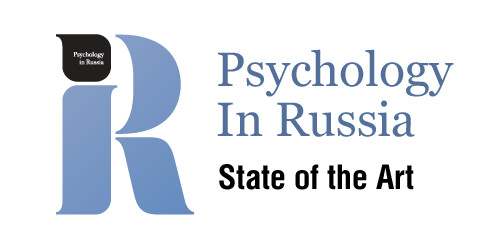Belyaeva, E.V.

Laboratory Assistant at the Center for Socio-Cultural Problems of Modern Education, Federal Scientific Center of Psychological and Interdisciplinary Research.
-
Characteristics of the Audience’s Experiences of Theatrical Narration (Based on the Play “An Absolutely Happy Village” Directed by P.N. Fomenko)Lomonosov Psychology Journal, 2025, 3. p. 244-267read more718
-
Background. Despite growing interest in the psychological aspects of art perception, empirical studies on this subject remain scarce in both Russian and international psychology. This is particularly true regarding theatrical perception.
Objective. This study examines the emotional-semantic score of audience perception through an analysis of P.N. Fomenko’s theatrical play “An Absolutely Happy Village”.
Study Participants. The study involved 50 audience members (74% female, aged 16–60: 46% 19–25 y.o.; 30% 26–45 y.o.; 18% 46–60 y.o.). Over half of the respondents (54%) held higher education degrees, while 30% had incomplete higher education. Participants demonstrated high theater engagement: 72% had attended performances more than twice in the preceding six months.
Methods. The research is grounded in L.S. Vygotsky’s conceptual approach to aesthetic response analysis and the distinctive nature of cathartic art experiences. The study employed: (1) comparative analysis of literary text and its theatrical interpretation; (2) an original anonymous questionnaire assessing theater engagement and play-specific perceptions; (3) a custom semantic differential-based tool measuring emotional responses to performance episodes.
Results. Findings reveal how stage interpretation facilitates audience engagement with existential themes. The audience’s emotional score emerges from a dialectic conflict between two affective dimensions: wellbeing vs. distress (reflecting the classical tragic “transition from happiness to misfortune”) and social acceptance vs. rejection of narrative events. Shifts in these “emotional-semantic melodies” stem from the director’s use of dual narrative sequencing in episode construction, enabling viewers to experience the complex emotional score of tragic catastrophe and catharsis.
Conclusions. The study findings contribute to understanding the psychological mechanisms of theatrical impact by revealing patterns in the formation of emotional-semantic perception of stage performances.
Keywords: catharsis; audience emotional response,; narrative structure of episodes; emotional evaluation; semantic differential; director’s interpretation; P.N. Fomenko DOI: 10.11621/LPJ-25-32
-
-
Revenge: a Modern View on a Historical ProblemLomonosov Psychology Journal, 2024, 2. p. 11-30read more2744
-
Background. The phenomenon of revenge has been widely studied in psychology since the beginning of the 20th century. Acts of revenge are considered in psychoanalysis, social, family, criminal, legal and other areas of psychology. Nowadays behaviour based on the motive of revenge is found in virtual environment. There is an ambivalent attitude towards revenge. On the one hand, a person who does not get revenge seems weak. On the other hand, seeking for revenge can be perceived as an unconstructive way of behaving. Despite the prevalence of revenge, there is no generally accepted opinion in psychological science regarding the definition of revenge.
Objectives. The aim of this work is to analyze various ideas about revenge and to highlight the components of vengeful behaviour, based on which the form of reciprocal aggression can be classified as revenge. The problem of distinguishing between the concepts of “revenge”, “retribution”, “resentment” and “punishment” is considered.
Results. Revenge has a significant difference from other forms of aggressive behaviour. Revenge is always a reaction to previous aggression. The motivational component includes two aspects: the desire to take revenge (revenge seeking) and he desire to maintain a comfortable level of self-esteem. Society has a dual function in relation to revenge: as an initial motive influencing the choice of response to resentment, and as a deterrent factor. The willingness to forgive is determined by moral development, a number of personal characteristics and changes in the motivational sphere.
Conclusions. In psychological science, the phenomenon of revenge is subjected to a thorough theoretical analysis. Due to the fact that revenge is an intrapersonal phenomenon, the development of methodological tools, including psychodiagnostic techniques, is necessary for the development of revenge research.
Keywords: revenge; retribution; revenge seeking; ressentiment; forgiveness DOI: 10.11621/LPJ-24-13
-
-
Psychometric Analysis of the Russian Version of “The displaced Aggression Questionnaire”Lomonosov Psychology Journal, 2025, 2. p. 158-187read more1089
-
Background. Displaced aggression is currently a common occurrence when a person is not able to respond directly to the offender, loosing temper at other uninvolved people. The Displaced Aggression Questionnaire was introduced as the first technique to assess differences in the severity of displaced aggression.
Objective. The study is aimed at adapting a questionnaire designed to measure the tendency towards displaced aggression.
Study Participants. The study involved 364 respondents aged from 18 to 69 years (Mage = 22; SD = 12.2; 243 women).
Methods. Three questionaries were used: the "Displaced Aggression Questionnaire" being adapted, the "BPAQ-24" questionnaire, which allows to measure three traits (anger, hostility, and physical aggression), and the "Vengeance and Forgiveness Questionnaire" ("The Vengeance scale") intended to measure characteristics of vengeance and forgiveness. For the psychometric properties of the adapted questionnaire, confirmatory factor analysis, correlation analysis, Cronbach's α coefficient, and Student's t-test are used.
Results. The Russian version of the Displaced Aggression Questionnaire includes three subscales. The scales "angry rumination" (Cronbach's α = 0.884) and "displaced aggression" (Cronbach's α = 0.909) have a structure, similar to the original structure of the questionnaire and include 10 items each. The "revenge planning" scale has a modified structure, including 6 items (Cronbach's α = 0.876). Correlation analysis revealed significant positive relationships of displaced aggression with anger and hostility. Gender differences were revealed: women are more prone to angry rumination and displaced aggression, while men are more prone to revenge planning.
Conclusions. Psychometric analysis supports the reliability-consistency and validity of the Russian version of the "Displaced Aggression Questionnaire". The instrument is recommended for application as a diagnostic tool for displaced aggression, angry rumination and revenge planning.
Keywords: revenge; revenge planning; aggression; displaced aggression; angry rumination; Displaced Aggression Questionnaire DOI: 10.11621/LPJ-25-16
-









